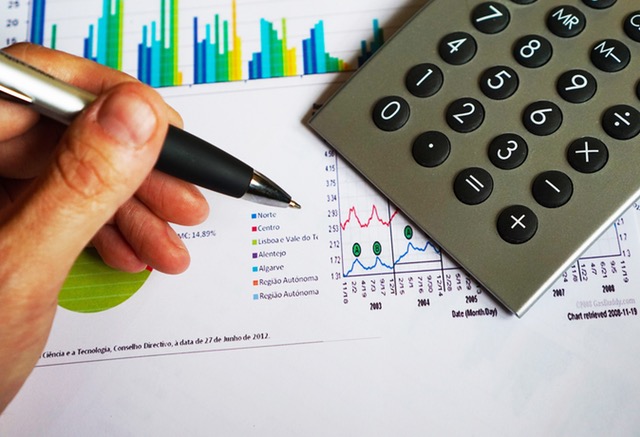
It is said that content is King.
Hubspot report revealed that business that engages in content marketing generate more traffic, leads, and customers than those who do not.
Armed with this information, you went ahead to create content for your business.
It actually brought traffic to your website
But:
Few percentages of your visitors convert to leads and sales.
Instead of the content to increase your revenue, you are losing it.
What can be wrong with your approach?
The major reason why a website will receive hoards of traffic and convert poorly is when the visitors have a bad experience. This alone can stop visitors from coming back to your website.
According to Consumer Insight Group, 83% of social media customer service users have walked away from a purchase after a bad experience.
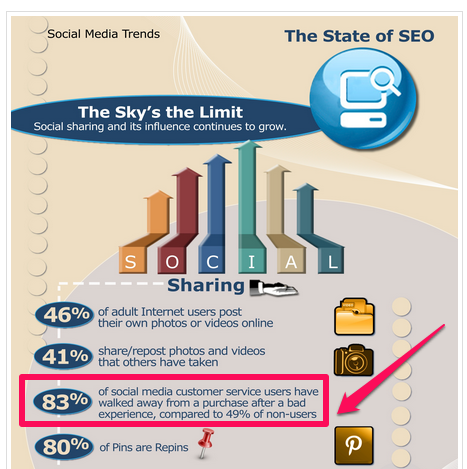
A study also reported that 40% of visitors don’t return to a website after having a negative experience.
This is critical because it can cause you massive loss in revenue if nothing is done to improve the situation.
Let’s attempt to properly diagnose the problem.
When a website has high traffic and low conversion, the bounce rate will be high.
This implies that your visitors are having a bad experience on your website. It could also mean that you are not attracting the right type of visitors. The implication of this scenario is that you will be losing revenue until you fix the problem.
So, here we will attempt to fix this problem.
But before we move on, let’s get it right by first looking at the definition of bounce rate.
What is a bounce rate?
A bounce rate as defined by Google Analytics is “the percentage of single-page visits (i.e. visits in which the person left your website from the entrance page). Bounce rate is a measure of visit quality and a high bounce rate generally indicates that site entrance (landing) pages aren’t relevant to your visitors”.
Jordan Louis, a web analytic Primer defined bounce rate as “the percentage of visitors who have accessed a website, loaded only one page, and then left“.
In other words, bounce rate is when a user lands on any page on your website and leaves without clicking on any other page.
What is an average bounce rate?
According to a survey carried out by gorocketful, an excellent bounce rate is 41-55%, an average bounce rate is 56-70%. More than 70% indicates a serious problem.

However, there are some exceptions to the rule. For instance, if you have a single-page website, you will have a high bounce rate. This is because there are no other pages for users to click on the website.
“as a benchmark from my own personal experience over the years, it is hard to get a bounce rate under 20%. Anything over 35% is a cause for concern and anything above 50% is worrying“.
How do you check your bounce rate?
How to check your bounce rate
Chances are you are using Google analytics for your website/blog. If you are not, you can quickly sign up for the service with your Gmail account. You can read this guide for directions if you are new to Google Analytics.
Log into your Google Analytics, click on Audience and then overview. You will see your bounce rate as shown below:
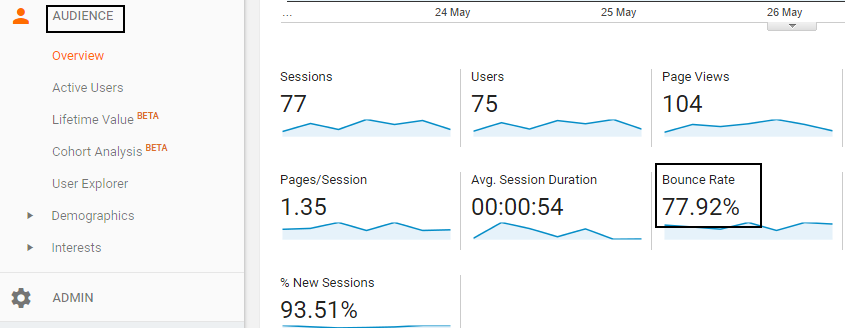
Now, you may ask, how does high bounce rate affect my revenue?
It’s like this:
Imagine there are two websites selling software products. They have the same number of visitors and the same conversion rate. But their bounce rates are different.
An average bounce rate is 56 – 70%. Let’s say Site X has a bounce rate of 60 percent. It implies that for every 1,000 visitors that come to Site X, only 400 of them will stay around to see what the site is selling.
According to Wordstream, an average conversion rate is between 2 – 4 percent. Based on this measurement, out of the 400 visitors that stays back on site X, about 8 to 16 people will buy the software. If the software costs $300, site X will make between $2,400 to $4,800 in revenue.
According to Avinash Kaushik, a bounce rate of 30 percent is good. So, let’s assume that the bounce rate of the second website – site Y is 30 percent. It has the same number of traffic (1,000 visitors) and the same conversion rate of 2-4 percent.
Site Y will have 700 visitors clicking around the website to buy the product. With the product price of $300, site Y will have between $4,200 to $8,400 in revenue.
That is a lot of revenue compared with what Site X made.
This is the reason why you need to critically look into your bounce rate and do all you can to fix it if it is too high.
Bounce rate is an effective metric for measuring the quality of your content, value proposition and the effectiveness of your messaging. If someone refuses to stay on your website for two seconds, then something is wrong with it.
One major cause of bounce rate is content that is not properly tailored to your audience journey. Creating content that does not meet your visitors need will continue to make you lose revenue.
The question is, how do you tailor your content to meet your visitors need?
The answer is to map your content to your buyer’s journey.
How to Map your content to your buyer’s journey
The buyer’s journey is also known as the purchase journey, buying cycle or customer journey.
Hubspot defined it as “the process buyers go through to become aware of, evaluate and purchase a new product or service“
In other words, it is the stages a customer goes through to purchase your product or service.
The buyer’s journey is in three major stages – the awareness stage, the consideration stage, and the decision stage. It is illustrated below:
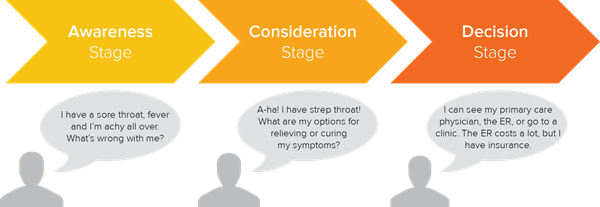
The awareness stage is also known as the top of the funnel (TOFU). It is where the buyer becomes aware of the problem or the solutions to the problem.
The consideration stage is also known as the middle of the funnel (MOFU). It is where the buyer understands the problem and needs more information to make an informed decision on the solution to use.
The decision stage is also known as the bottom of the funnel (BOFU). It is where the buyer has a variety of solutions but need to streamline it to choose the best.
Understanding the type of content to provide for each stage will help you to create useful content assets that will benefit your visitors.
According to Pardot’s report, 76% of buyers prefer different content at each stage of their research.
Why do you need to map your content to these stages?
A Recent study shows that 67 percent of the buyer’s journey is done online. Also, 94% of B2b buyers research online before making a purchase decision.
The statistics above shows that businesses that have content in place for each stage of the journey can meet their customers wherever they are in the buyer circle.
Let’s start with an example.
Take a look at Desk.com, a customer service software tool.
The company did an excellent job in mapping their content to the buyer’s journey. See it below:
1. Awareness stage (TOFU): What is customer service? (And why is it important?)
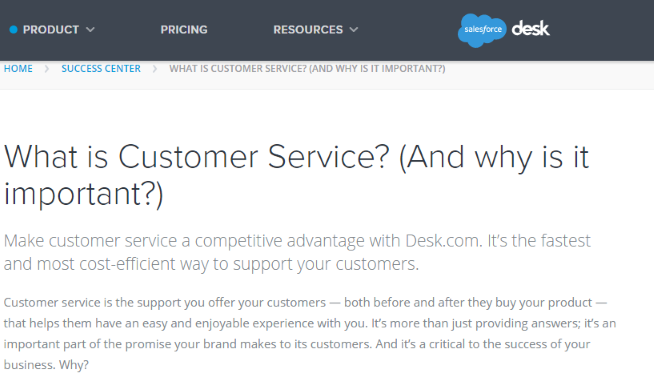
2. Consideration stage (MOFU): Choosing the perfect customer service app
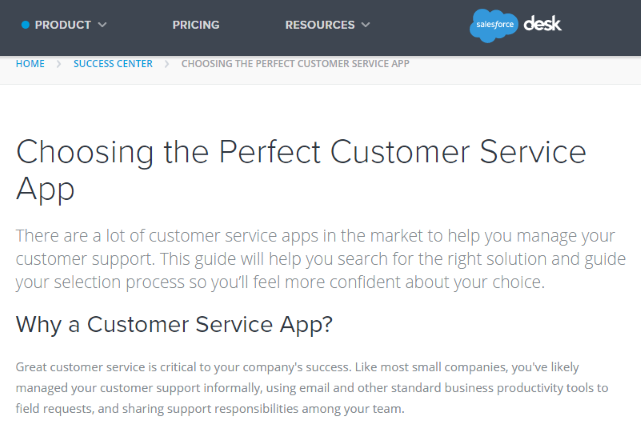
3. Decision stage (BOFU): The best Zendesk alternative is Desk.com
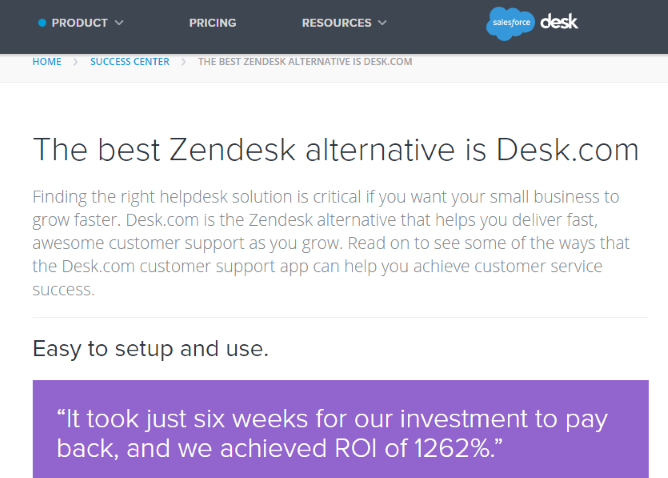
So, which type of content is suitable for each buyer’s journey stage?
Content type for the buyer’s circle
When a potential buyer first starts to research a product or service, they search for basic information.
This is the kind of content that speaks to their pain points without selling to them.
From there, they move to the consideration stage looking for more in-depth content, such as e-books and reports. This will further enlighten them on whether you are the right fit for them or not.
When they are certain they want the product, they start comparing your product or service with that of your competitors’. They do this in order to be able to choose the best one that will solve their problem. This is illustrated in the image below:
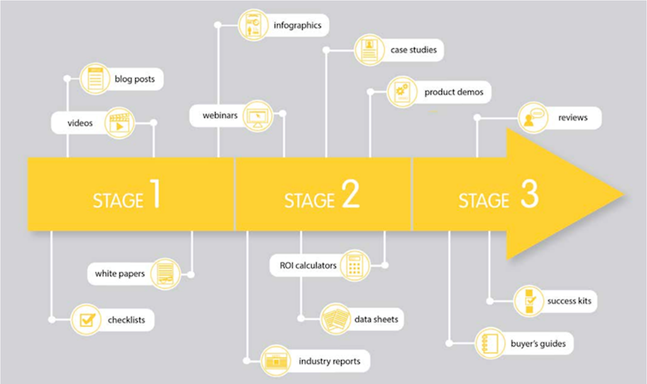
Mapping content to the top of the funnel (TOFU) – The awareness stage
The awareness stage is where the buying circle starts. Creating the right type of content for this stage is very critical.
Most of the people that come to your website may not be looking for solutions right from the onset. They want to know more about their pain points before looking for appropriate solutions.
At this stage, your content should be educative, interesting and engaging. It should connect with your prospective customer. You should avoid any form of sales pitches at this stage.
The keywords you can use to create content for this stage includes but not limited to What is, How to, etc. For instance, visitor searching for customer care software can start with:
What is customer care?
What is customer care service?
What is customer service software?
Below are four major types of content that are suitable for this stage:
1. Blogs Posts
Blog posts are perfect for educating your audience. Here, you can write on informative topics that will further broaden the knowledge of your prospects on your product or service.
You can search for keywords that visitors are using at this stage.
This type of content will help your audience to have a better understanding of what you are selling. It will help them to dig more into other content types on your website.
For example, check out Shopify’s blog posts below:
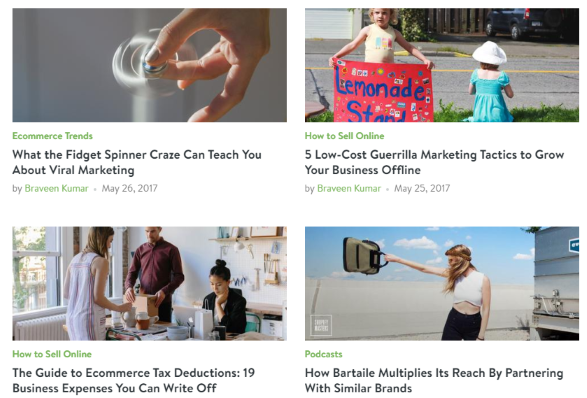
2. Expert content
Expert content includes Guides, report, and pillar content that is filled with detailed information. This will help you to raise awareness for your product and service as a good option that can fix your customers’ pain points.
A Good example of a company that is doing this very well is Kissmetrics, a web analytic company.
They created different guides in three different categories (general marketing, email marketing, and social media marketing). See it below:
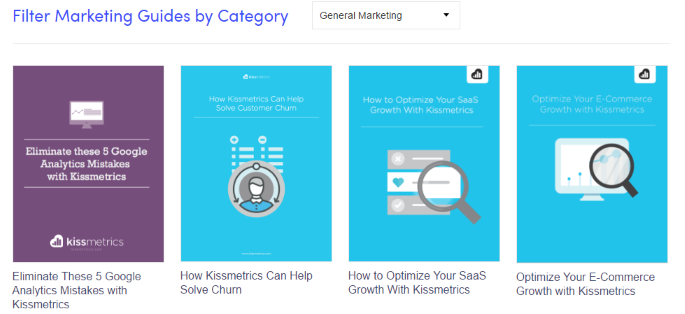
3. Videos, presentations, and podcasts
According to Outbrain, 87% of online marketers use video content. Also, the web video marketing council study revealed that 73% of respondents in the study indicated that video had a positive impact on their marketing results.
Video creates awareness and greatly help in brand building. A good example of a business that does this well is Evernote. They have different videos for their products. Find the page below:

4. Infographics
Infographics contain tons of data and big ideas. They are a great way to present complex data easily and clearly.
They increase brand awareness, establish subject matter expertise and improves SEO. A company that does this well again is Kissmetrics. They have dozens of infographics. See it below:

Mapping content to the Middle of the funnel (MOFU) – The Consideration Stage
The consideration stage is an important stage in the buying circle. In this stage, the prospect is already aware of the problem they are having, and they have enough information on it.
Here, you will be creating content that enlightens them about your company’s product or services. This is where you need to educate them more.
The keywords you can use to create content for this stage includes but not limited to words that start with Best, Top, Cheap, etc. For instance, using the same customer care software niche, visitors at this stage can search for:
Best customer service platforms
Top help desk ticketing system
Cheap help desk software
There are three good content types you can create to capture their attention:
1. E-books
Downloadable e-books that are detailed provide more valuable information to your prospects. It is also a great way to build your email list and It is a great way to get your prospects interested in your product or service.
It does not look like a marketing material which makes it more amenable to prospective customers at large.
An example of a company that does this well is Kapost. They created a lot of resources for their audience’s enlightenment and education.

2. Webinars
Webinars is a great way to gently persuade your prospective clients to purchase your product or service. It allows you to present information that generates interest in your product or service.
The question and answer segment allows you to address your prospective customers’ concerns.
A good example of a company that has an array of webinars is Unbounce. They use webinars to market their product.
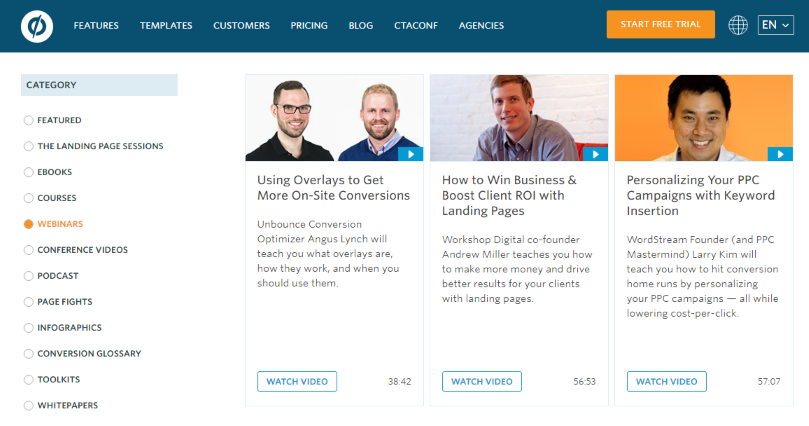
3. Whitepapers
Whitepapers are one of the most effective marketing strategies for reaching your prospective customers. They provide a chance to showcase your industry expertise and help you to attract customers.
If you are looking for a company that offers tantalizing whitepapers, check out Tableau Software s (an analytic company) library of whitepapers below:
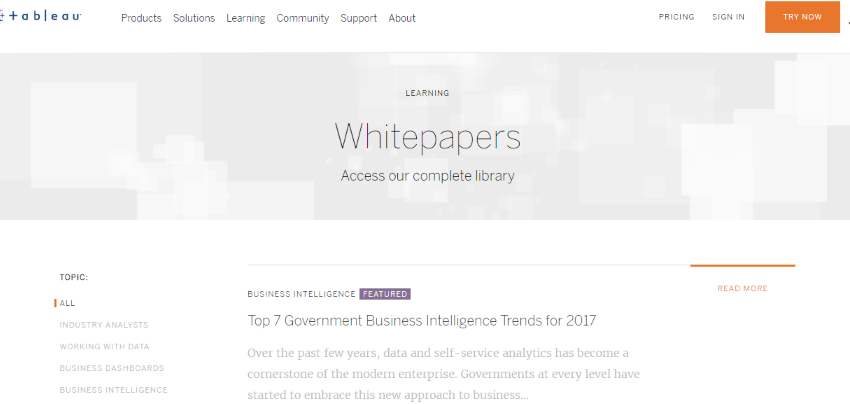
Mapping content to the Middle of the funnel (BOFU) – The Consideration Stage
This is the most important stage of the buying circle. It is now time to offer your product directly as a solution to your prospective buyer’s problem.
Here, the prospect has read and watched your contents. It is time to make a decision. The content you offer here must assist your prospect to make an informed decision.
The keywords you can use to create content for this stage includes but not limited to words that contain vs, reviews, comparison, etc. For instance, using the same customer care software niche, visitors at this stage can search for:
Zendesk ticketing system
Salesforce desk vs. Zendesk
Desk.com review
The type of content you can offer your audience in this stage are enumerated below:
1. Reviews/Comparison
You need to create a review of your product showing the features, benefits, how it works and how it can solve your prospects’ pain points.
You can also decide to compare it with a similar product in your niche. For example, Zendesk created an article on “A guide for small business: choosing the right customer service software” where they compared three customer care services – Zendesk, Desk, and Freshdesk.
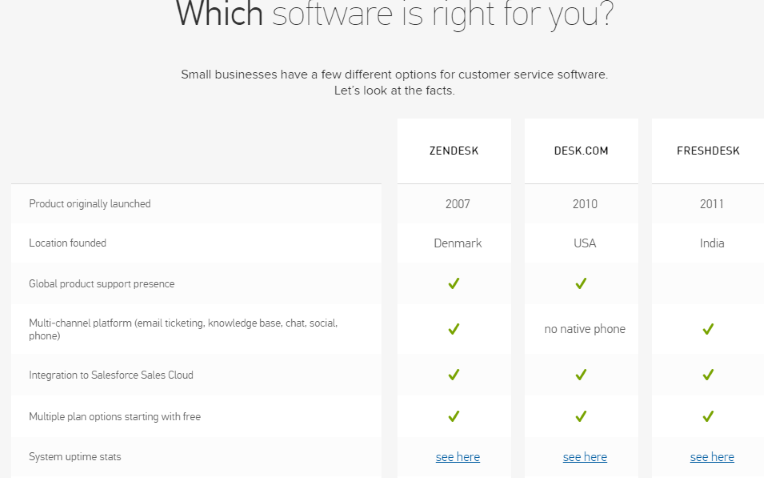
2. Demo /live videos
Demo videos have the capacity to quickly turn prospective buyers into customers. They show visitors how your product works in real life.
They dispel all myths and rumors about your product, increasing the confidence of your prospective customers. A great company that does this well is Marketo, a marketing automation company
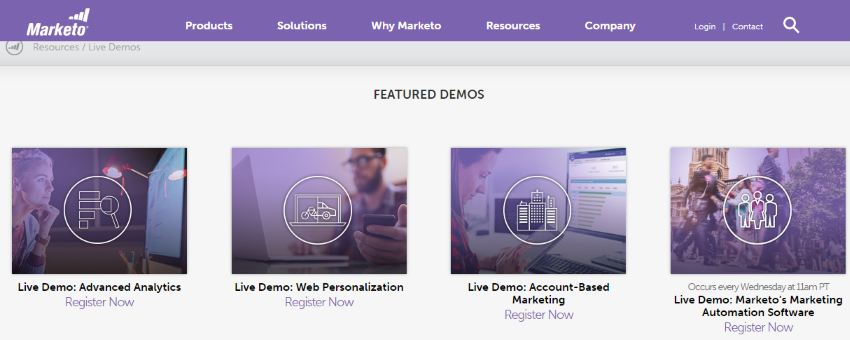
3. Customer stories/case studies
Case studies are an effective marketing tactics. According to Content Marketing Institute report, case studies are one of the top three most important marketing tactics used by b2b marketers.
Case studies show a company’s reliability and trustworthiness. It makes it easy for customers to trust such brand.
A great example of a company that does this well is SOASTA, a web performance optimization, and testing software.
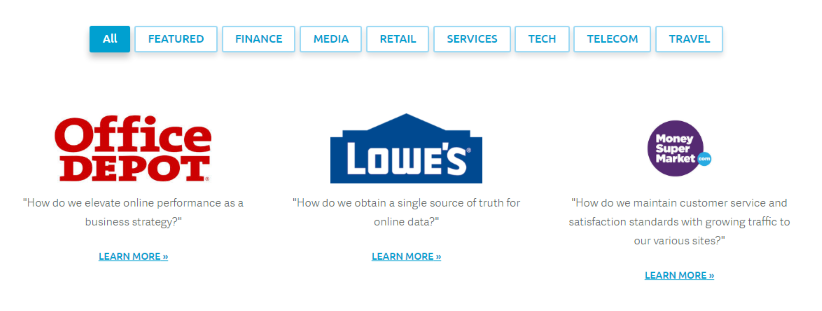
If you are able to create some of the content above for your business, it will greatly solve the issue of high bounce rate – lots of traffic, little or no conversion. You can do this by engaging the services of a professional content writer to create an array of content for your audience. Your audience will have a variety of content to interact and engage with.
When you do this, you will not lose revenue anymore; you will rather increase your bottom line.
What other ways can you reduce your bounce rate? Let’s discuss in the comment section.